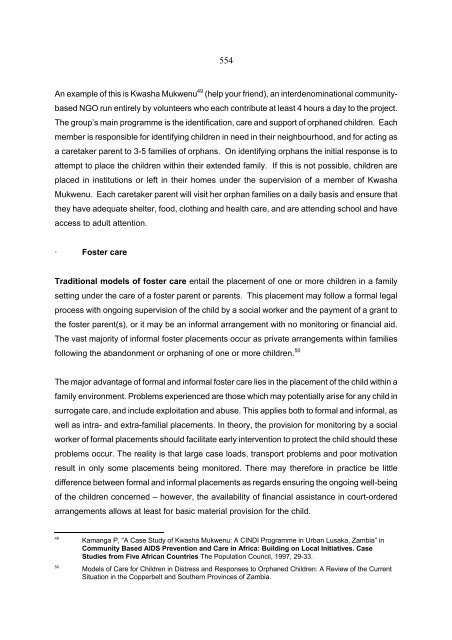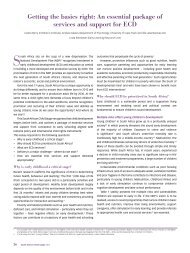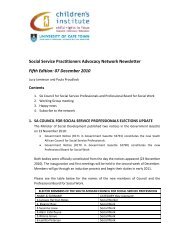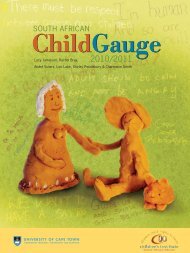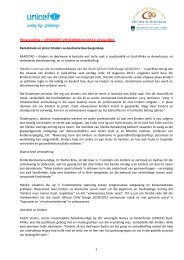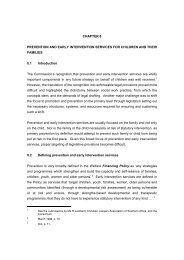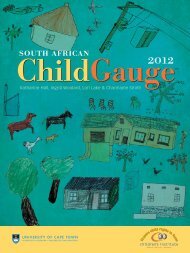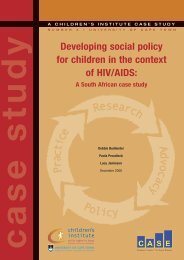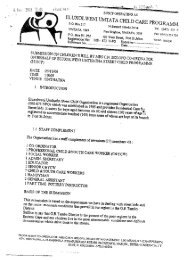Chapter 13 - Children in need of special protection - Children's ...
Chapter 13 - Children in need of special protection - Children's ...
Chapter 13 - Children in need of special protection - Children's ...
Create successful ePaper yourself
Turn your PDF publications into a flip-book with our unique Google optimized e-Paper software.
554An example <strong>of</strong> this is Kwasha Mukwenu 49 (help your friend), an <strong>in</strong>terdenom<strong>in</strong>ational communitybasedNGO run entirely by volunteers who each contribute at least 4 hours a day to the project.The group’s ma<strong>in</strong> programme is the identification, care and support <strong>of</strong> orphaned children. Eachmember is responsible for identify<strong>in</strong>g children <strong>in</strong> <strong>need</strong> <strong>in</strong> their neighbourhood, and for act<strong>in</strong>g asa caretaker parent to 3-5 families <strong>of</strong> orphans. On identify<strong>in</strong>g orphans the <strong>in</strong>itial response is toattempt to place the children with<strong>in</strong> their extended family. If this is not possible, children areplaced <strong>in</strong> <strong>in</strong>stitutions or left <strong>in</strong> their homes under the supervision <strong>of</strong> a member <strong>of</strong> KwashaMukwenu. Each caretaker parent will visit her orphan families on a daily basis and ensure thatthey have adequate shelter, food, cloth<strong>in</strong>g and health care, and are attend<strong>in</strong>g school and haveaccess to adult attention.· Foster careTraditional models <strong>of</strong> foster care entail the placement <strong>of</strong> one or more children <strong>in</strong> a familysett<strong>in</strong>g under the care <strong>of</strong> a foster parent or parents. This placement may follow a formal legalprocess with ongo<strong>in</strong>g supervision <strong>of</strong> the child by a social worker and the payment <strong>of</strong> a grant tothe foster parent(s), or it may be an <strong>in</strong>formal arrangement with no monitor<strong>in</strong>g or f<strong>in</strong>ancial aid.The vast majority <strong>of</strong> <strong>in</strong>formal foster placements occur as private arrangements with<strong>in</strong> familiesfollow<strong>in</strong>g the abandonment or orphan<strong>in</strong>g <strong>of</strong> one or more children. 50The major advantage <strong>of</strong> formal and <strong>in</strong>formal foster care lies <strong>in</strong> the placement <strong>of</strong> the child with<strong>in</strong> afamily environment. Problems experienced are those which may potentially arise for any child <strong>in</strong>surrogate care, and <strong>in</strong>clude exploitation and abuse. This applies both to formal and <strong>in</strong>formal, aswell as <strong>in</strong>tra- and extra-familial placements. In theory, the provision for monitor<strong>in</strong>g by a socialworker <strong>of</strong> formal placements should facilitate early <strong>in</strong>tervention to protect the child should theseproblems occur. The reality is that large case loads, transport problems and poor motivationresult <strong>in</strong> only some placements be<strong>in</strong>g monitored. There may therefore <strong>in</strong> practice be littledifference between formal and <strong>in</strong>formal placements as regards ensur<strong>in</strong>g the ongo<strong>in</strong>g well-be<strong>in</strong>g<strong>of</strong> the children concerned – however, the availability <strong>of</strong> f<strong>in</strong>ancial assistance <strong>in</strong> court-orderedarrangements allows at least for basic material provision for the child.4950Kamanga P, “A Case Study <strong>of</strong> Kwasha Mukwenu: A CINDI Programme <strong>in</strong> Urban Lusaka, Zambia” <strong>in</strong>Community Based AIDS Prevention and Care <strong>in</strong> Africa: Build<strong>in</strong>g on Local Initiatives. CaseStudies from Five African Countries The Population Council, 1997, 29-33.Models <strong>of</strong> Care for <strong>Children</strong> <strong>in</strong> Distress and Responses to Orphaned <strong>Children</strong>: A Review <strong>of</strong> the CurrentSituation <strong>in</strong> the Copperbelt and Southern Prov<strong>in</strong>ces <strong>of</strong> Zambia.


